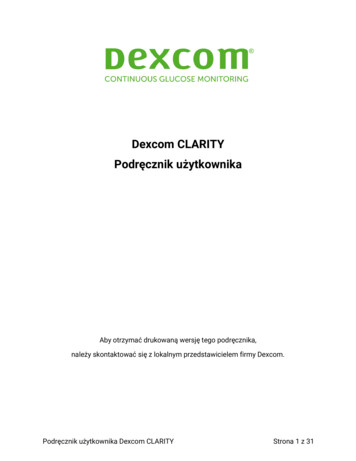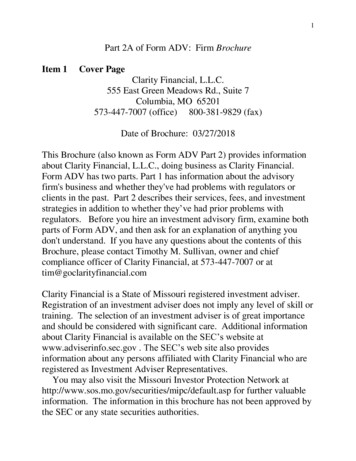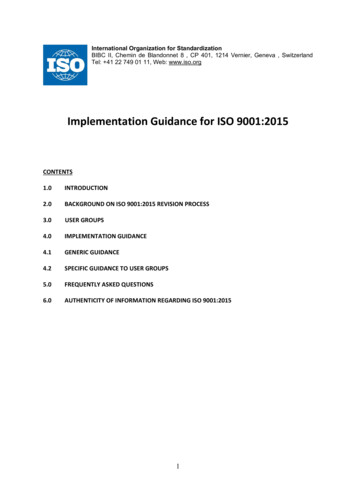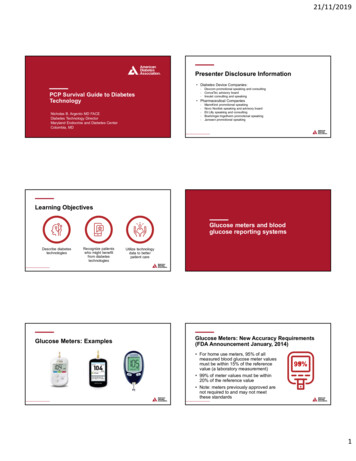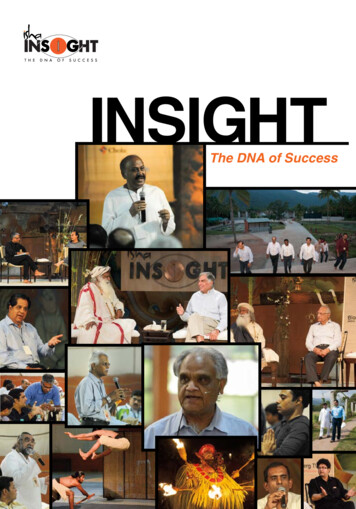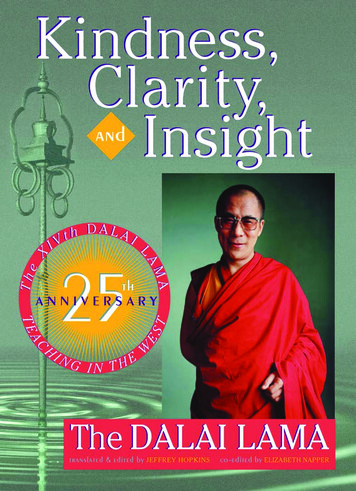
Transcription
Kindness, Clarity, and Insight
Kindness, Clarity, & Insight.The Fourteenth Dalai LamaHis Holiness Tenzin GyatsoRevised and UpdatedEdited and translated by Jeffrey HopkinsCo-edited by Elizabeth NapperSnow Lion Publicationsithaca, new york boulder, colorado
Snow Lion PublicationsP. O. Box 6483Ithaca, NY 14851 USA(607) 273-8519www.snowlionpub.comCopyright 2006 His Holiness the Fourteenth Dalai LamaAll rights reserved. No part of this book may be reproduced withoutprior written permission from the publisher.Copyright in the photographs is held by the respective photographerswith the following exceptions:Brian Beresford’s photographs Brian Beresford/Nomad PicturesAlison Wright’s photographs Alison Wright PhotographyJacqui Walker’s photograph Dalai Lama Trust New ZealandMitchell Layton’s photograph The Mind and Life InstitutePrinted in USA on acid-free recycled paper.ISBN-10 1-55939-251-7ISBN-13 978-1-55939-251-8The Library of Congress catalogued the previous editionof this book as follows:Bstan-’dzin-rgya-mtsho, Dalai Lama XIV, 1935Kindness, clarity, and insight / the Fourteenth Dalai Lama, his HolinessTenzin Gyatso ; translated and edited by Jeffrey Hopkins ; co-edited byElizabeth Napper.p. cm.ISBN 0-937938-18-1 (pbk.)1. Buddhism—Doctrines. 2. Buddhism—China—Tibet.I. Hopkins, Jeffrey. II. Napper, Elizabeth.BQ7935.B774K56 1984294.3’4—dc1984-51198Designed and typeset by Gopa & Ted2, Inc
C ONTENTS.Preface7Editors’ Note13Religious Values and Human Society15The Luminous Nature of the Mind25Four Noble Truths29Karma35Medicine of Wisdom and Compassion39Altruism and the Six Perfections43Religious Harmony57Treasures of Tibetan Buddhism63Compassion in Global Politics71Meditation79Buddhism East to West99Deities111Eight Verses for Training the Mind117O Ma i Padme HÒ 135The Path to Enlightenment137
6 kindness, clarity, and insightSelf and Selflessness179Tibetan Views on Dying191Transforming the Mindthrough Meditation207The Two Truths217Union of the Oldand New Translation Schools227Notes255
.P REFACEnow Lion Publications, now celebrating its twentyfifth year as the preeminent publisher of books exclusively on Tibet and Tibetan Buddhism, grew out ofthe wish to make available to the general public the profoundlyappealing series of lectures that His Holiness the Dalai Lama gavein the United States in 1979 and 1981, and in Canada in 1980.Although the Dalai Lama had escaped from Tibet to India duringa public demonstration against the Chinese Communist occupation in 1959, the U.S. government repeatedly had caved in to Chinese pressure and did not allow him to visit this country until theCarter Administration in 1979.Prodded by Joel McCleary, deputy assistant to President Carter,and myself at a meeting in the White House with key staff fromthe National Security Council, the Carter Administration (whichfrom its inception was concerned with human rights) undoubtedly saw the human rights issues involved, and agreed to permitthe Dalai Lama’s visit. Although they requested a six-month delaybefore the visit, this fit right in with our wishes, since extensivepreparations had to be made by the Office of Tibet in New Yorkunder the leadership of Tenzin Tethong (later to become PrimeMinister of the exiled Tibetan government headquartered inDharamsala, India) for what became a forty-nine day, twenty-fourcity lecture tour with sixty-seven talks. The first planning meet-S
8 kindness, clarity, and insighting between McCleary, Tenzin Tethong, and myself began inMcCleary’s office in the Executive Office Building several daysafter the meeting at which approval was given for the trip, andcontinued through lunch in the restaurant under the Oval Officein the White House. McCleary and Deputy Assistant to the President Tom Beard were particularly effective in overcoming manybureaucratic obstacles to the Dalai Lama’s final visa approval, making Washington contacts with future friends and allies of His Holiness such as Congressman Charlie ose, and arranging for securitythroughout the trip for the then relatively unknown Dalai Lama.Tenzin Tethong formed a committee to arrange the details ofthe visit, which focused on the content of the lectures and avoidedany media hype. This meant that His Holiness’ introduction to theU.S. was on the basis of his message of compassion, meditativeconcentration, and examination of reality, leading to the title ofthe collection of his talks in this book, Kindness, Clarity, andInsight.Broad in scope and revealing the depths of his knowledge, thelectures moved from the East Coast to the South, the Midwest, theWest Coast, the Upper Midwest, and again the East Coast. Theseteachings introduced the range of the Dalai Lama and his message in a dynamic and concise way to the English-speaking world,covering a plethora of topics—the need for compassion in society and the world, the cause and effect of karma, the four nobletruths, the luminous nature of the mind, the common goals of theworld’s religions, meditative concentration, emptiness and selflessness, the two truths, and the fundamental innate mind of clearlight that all the various schools of Tibetan Buddhism aim at manifesting. Although others in Tibet have mentioned that all ordersof Tibetan Buddhism have the same basic outlook, His Holinesshas been the first to explain in detail how this is so, his brilliantsyncretic exposition being the final chapter in this book.
preface 9In 1979 the only books by the Dalai Lama in English, or anyother language except Tibetan, were his autobiography, My Landand My People, and The Buddhism of Tibet and the Key to the Middle Way. In Ithaca, New York, and later in Toronto, the young, idealistic, compassionately motivated but nearly penniless founders ofSnow Lion Publication approached His Holiness for counsel onhow to communicate the breadth and depth of Tibetan Buddhismto the English-speaking world. The Dalai Lama quickly expressedhis enthusiasm for a publishing house that could serve two audiences. In his own words (recorded during that audience):Basically, two main types of books are needed: one chiefly forstudy by scholars and academically minded practitioners andanother primarily for practitioners without much concernfor deeper philosophy. These two basic types are essentiallythe same, but have slightly different approaches. One is moredetailed, while the other is more condensed. If you can makeboth of these available, that would be excellent.Snow Lion has brilliantly succeeded in both of these avenues,providing a massive, diverse body of texts for an ever-growingaudience throughout the world where interest in Tibetan Buddhism has spread. Although many publishing houses have produced books on Tibet and Tibetan Buddhism, Snow Lion hasremained, through thick and thin, the only one publishing exclusively in this area, keeping almost all of its back list of over twohundred titles in print throughout these twenty-five years. Thus,the apparent leap of confidence in permitting this unknown,underfunded, inexperienced company to publish this importantfirst book of his teachings in the West has borne rich fruit.In addition, His Holiness counseled the founders of Snow Lionto be nonsectarian and unbiased in their efforts and to publish
10 kindness, clarity, and insightwhat is of value from all schools of Tibetan Buddhism and fromBön, the pre-Buddhist religion of Tibet. Following His Holiness’advice, Snow Lion has been remarkably successful in becoming aplatform for all of Tibet’s great spiritual traditions.It all began with this book, Kindness, Clarity, and Insight, thefirst book of teachings by the Dalai Lama in the English-speakingworld. Foundational to His Holiness’ message, it is now reissued inthis celebratory twenty-fifth year. With this book serving as amodel, scores of writers have been inspired to turn his oral teachings into books; it is likely that the Dalai Lama has inspired morewriters to work with him on publications than any other personin the world, these mutual efforts now totaling more than sixtybooks.Kindness, Clarity, and Insight draws on his lecture tours in theUnited States in 1979 and 1981, and in Canada in 1980. The DalaiLama spoke at scores of universities, colleges, ecumenical gatherings, Buddhist centers, and public meetings, gradually explaininghis message of the need for kindness, compassion, concentration,and penetrative insight in the world. Serving as interpreter, I wascontinually amazed and moved at the personal relevance of hismessage, its practicality and applicability, for as he says, humansociety begins with people and specifically our capacity to recognize in others our common aspirations to happiness. The appealis to the heart by way of the mind, using reason and sense to curbselfishness and to generate deeply felt altruism based on wisdom.Although the teachings in this book are the result of just thefirst three trips of the Dalai Lama in North America, they comprehend and encapsulate in a concise and crisp manner all of thetopics to which he has returned repeatedly, and eloquently, in hissubsequent speaking tours—the core subject matter of TibetanBuddhism. eaders of this single volume, undaunting in size, willbe well prepared for understanding all of the Dalai Lama’s subse-
preface 11quent books. Translated into twelve languages, including Tibetan,the book remains the heart-message of this great world leader.The book contains presentations of basic Buddhist doctrines—how to develop clarity of mind useful in all walks of life and howto penetrate beyond appearances to the profound nature of bothpersons and other phenomena, thereby negotiating the conflictbetween appearance and reality. His is a message of hope, both interms of the potential for individual and social transformation andin terms of the potential of the human spirit.Centering around fundamental Buddhist attitudes that are atthe core of His Holiness the Dalai Lama’s outlook, the twentychapters are deliberately arranged in a developmental sequence soas to allow the reader to acquire the necessary background to appreciate the more complex, later topics.1 Thus, the teachings in thisbook, taken as a whole, provide a map of Tibetan spiritual culture.The Political SituationThe Dalai Lama has directed the rebuilding of Tibetan culturalinstitutions outside of Tibet in India and Nepal. Also, asking religious and political leaders of the world to look beyond narrowinterests to the greater good, he has advocated attention to thefundamental need of society regardless of religion or politics—kindness. But when the Chinese Communist government in Beijing hears that the Dalai Lama has been invited to visit a country,it immediately objects to that government, which sometimes thenfinds his visit to be inconvenient, or downscales the visit, or makesit “personal.” What do they fear? The Dalai Lama has no army, noeconomic pressure, no political cards to play. He advocates nonviolence and compassion.In 1978, the Chinese Communist government in Beijingoffered to negotiate anywhere at anytime if the Dalai Lama would
12 kindness, clarity, and insightnot bring up the topic of independence. He agreed to this condition, but the response for now almost three decades has been torefuse to engage in substantive talks. What do they fear?His power comes from a life of ethics, the force of truth. InTibetan, he speaks with a range, depth, inspiration, humor, and sincerity that inspire insight and motivate dedication to others’ welfare. I have often wished that all the world could hear this marvelin his own tongue.His full name is rJe btsun ’jam dpal ngag dbang blo bzang ye shesbstan ’dzin rgya mtsho srid gsum dbang bsgyur mtshungs pa med pa’isde dpal bzang po, which in English, syllable-by-syllable, is “LeaderHoliness-Gentleness- olling-Unparalleled-Glory-Integrity.” Many yearsago, I wrote a poem around his name which I would like to sharewith you:Leader of the world recognized for true holiness,Gentleness personified in persuasive renown,Speech of compassion pervading the planet in its dominion,Mind of altruistic endeavor reaching all in its goodness,Primordial in the depth and range of profound wisdom,Teaching encompassing all phenomena in its hold,Vastness of love’s deeds rippling throughout life’s ocean,Being so merciful displayed in suffering’s triad,Controlling the unruly through kindness unparalleled,Glory in forms of endeavor sealed in total integrity,May the teacher of the world, bearing compassionAnd wisdom indissoluble, see all obstacles dissolve.Jeffrey HopkinsProfessor Emeritus of Tibetan StudiesUniversity of Virginia
.E DITORS’ N OTEccasional footnotes have been provided by theeditors giving brief explanations, references tosupplementary material, and references for quotations, the latter kindly located in the Tibetan by Kensur YesheThupten. In rendering Sanskrit words in the body of the text, ch,sh, and h are used in place of c, Ÿ, and for the sake of easy pronunciation. Transliteration of Tibetan is done in accordance witha system devised by Turrell Wylie (see “A Standard System ofTibetan Transcription,” Harvard Journal of Asiatic Studies 22(1959):261-267).O
.R ELIGIOUS V ALUESAND H UMAN S OCIETYconstitution hall, washington, d.c.Introduction byCongressman Charles G. Rosehis is a holy instant for all Americans. Speaking onbehalf on my colleagues in Congress who are joiningto welcome His Holiness to Capitol Hill tomorrow Iwant to thank you for coming tonight to Constitution Hall. Ithank you because the United States Government is enriched bythis visit.I have read about the Buddhist concepts of karma and dharma.I even reviewed the 227 rules that Buddhist monks must follow,and then I realized how much I have to learn. But I came to theconclusion that what it is all about is self-awareness. Enlightenment starts within the individual. And if America is to cope withits current dilemmas, it must reach a higher level of consciousnessthan the level at which our problems were created. The belief ofTibetan Buddhism in the evolution of the individual is harmonious with the desire of a growing number of our citizens for spiritual growth to reach a higher consciousness. People involved withspiritual belief too often renounce politics and ordinary life. WhatHis Holiness teaches is that one aspect of life connects with everyother. Political solutions are linked directly with spiritual growth,T
16 kindness, clarity, and insightand that is why this visit is so timely for America. The message ofTibetan Buddhism is entirely consistent with our Jewish andChristian heritage. The visionary humanism of His Holiness mayeven help us to find a more authentic expression of the religionswith which we are familiar. All the world’s religions lead along thesame path.This visit comes appropriately within a month of the arrival ofanother great spiritual leader, His Holiness, the Pope of the oman Catholic faith. We in Washington are grateful to receivethese visits and to heed the insights of those conversant with thiswisdom, a wisdom to which politicians aspire but seldom achieve.The Dalai Lama encourages people to think more for themselves,and that is essential for our nation and our world. His Holiness hasnourished the seed of Buddhism which is growing in the UnitedStates, but America’s reverence for such ideals is not new. TheAmerican poet Henry Thoreau spoke of love of Jesus Christ andlove of the Buddha, but said that love was the main thing.Our nation has been involved in the tragic wars of Asia. But thetime has now come when we are well-advised to involve ourselvesin a better understanding of the great peaceful teachings of Asiasuch as Tibetan Buddhism, and let us seek paths of love and consciousness and personal transformation. His Holiness is a guide toenlightenment; we respect his quiet strength, a spiritual power thatcannot be suppressed even if lands are occupied and temples areclosed and prayers are suppressed. History has taught that oppression is transformed by faith and that oppressors eventually getwhat they resist.We meet in this hall which honors the Constitution of theUnited States. I remind you of the first amendment to the Constitution which states that the “Congress shall make no lawrespecting an establishment of religion, or prohibiting the freeexercise thereof.” Tonight we celebrate the free exercise of reli-
relig ious values and human society 17gion, in this instance, the Buddhism of Tibet, in this historic hall.We do so by welcoming the distinguished spiritual and temporal leader of Tibet, His Holiness the Dalai Lama. It is my greathonor to introduce to this group of his friends and followers HisHoliness.His Holiness the Dalai Lama’s Talkn one way—in material terms—this present generationhas reached a high level of development. Yet at the sametime, we human beings are facing many problems. Someare due to external events or causes, such as natural disasters. Thesewe cannot avoid. However, many problems are created by our ownmental defects; we suffer due to an internal lack. I call these problems unnecessary ones, for if we adopt a right mental attitude,these man-made problems need not arise.Often they are due to differences in ideology, and unfortunatelydifferent religious faiths are also sometimes involved. Hence it isvery important that we have a right attitude. There are many different philosophies, but what is of basic importance is compassion,love for others, concern for others’ suffering, and reduction ofselfishness. I feel that compassionate thought is the most preciousthing there is. It is something that only we human beings candevelop. And if we have a good heart, a warm heart, warm feelings, we will be happy and satisfied ourselves, and our friends willexperience a friendly and peaceful atmosphere as well. This can beexperienced nation to nation, country to country, continent tocontinent.The basic principle is compassion, love for others. Underlyingall is the valid feeling of “I,” and on a conventional level there isan “I”— “I want this,” “I do not want that.” We experience thisI
18 kindness, clarity, and insightfeeling naturally, and naturally we want happiness—“I want happiness,” “I do not want suffering.” Not only is it natural, it is right.It needs no further justification; it is a natural feeling validated simply by the fact that we naturally and correctly want happiness anddo not want suffering.Based on that feeling, we have the right to obtain happiness andthe right to get rid of suffering. Further, just as I myself have thisfeeling and this right, so others equally have the same feeling andthe same right. The difference is that when you say “I,” you arespeaking of just one single person, one soul. Others are limitless.Thus, you should visualize the following: On one side imagineyour own “I” which so far has just concentrated on selfish aims.On the other side imagine others—limitless, infinite beings. Youyourself are a third person, in the middle, looking at those oneither side. As far as the feeling of wanting happiness and notwanting suffering, the two sides are equal, absolutely the same.Also with regard to the right to obtain happiness they are exactlythe same. However, no matter how important the selfishly motivated person is, he or she is only one single person; no matter howpoor the others are, they are limitless, infinite. The unbiased thirdperson naturally can see that the many are more important thanthe one. Through this, we can experience, can feel, that the majority—the other limitless beings—are more important than the single person “I.”Thus, the question is: Should everyone be used for my attainment of happiness, or should I be used to gain happiness for others? If I am used for these infinite beings, it is right. If others areused for this single “I,” it is absolutely wrong. Even if you can usethese others, you will not be happy, whereas if this one single onecontributes, serves as much as he or she can, that is a source ofgreat joy. It is in terms of this attitude that real compassion andlove for others can be developed.
relig ious values and human society 19Compassion that is based on such reasoning and feelings can beextended even to one’s enemies. Our ordinary sense of love andcompassion is actually very much involved with attachment. Foryour own wife or husband, your parents, your children, you havea feeling of compassion and love. But because it is in fact relatedwith attachment, it cannot include your enemies. Again it is centered on a selfish motivation—because these are my mother, myfather, my children, I love them. In contrast to this is a clear recognition of the importance and rights of others. If compassion isdeveloped from that viewpoint, it will reach even to enemies.In order to develop such a motivation of compassion, we musthave tolerance, patience. In the practice of tolerance, your enemyis the best teacher. Your enemy can teach you tolerance whereasyour teacher or parents cannot. Thus from this viewpoint, anenemy is actually helpful—the best of friends, the best of teachers.In my own experience, the period of greatest gain in knowledge and experience is the most difficult period in one’s life. Ifyou go along in an easy way, with everything okay, you feel everything is just fine. Then one day when you encounter problems,you feel depressed and hopeless. Through a difficult period youcan learn, you can develop inner strength, determination, andcourage to face the problem. Who gives you this chance? Yourenemy.This does not mean that you obey or bow down to your enemy.In fact, sometimes, according to the enemy’s attitude, you mayhave to react strongly—but, deep down, calmness and compassionmust not be lost. This is possible. Some people may think, “Nowthe Dalai Lama is talking nonsense,” but I am not. If you practicethis, if you test it in your own experience, you can feel it yourself.The development of love and compassion is basic, and I usually say that this is a main message of religion. When we speak ofreligion, we need not refer to deeper philosophical issues. Com-
20 kindness, clarity, and insightpassion is the real essence of religion. If you try to implement, topractice, compassion, then as a Buddhist, even if you do not placemuch emphasis on the Buddha, it is all right. For a Christian, ifyou try to practice this love, there is no need for much emphasison other philosophical matters. I say this in a friendly way. Theimportant thing is that in your daily life you practice the essentialthings, and on that level there is hardly any difference betweenBuddhism, Christianity, or any other religion. All religions emphasize betterment, improving human beings, a sense of brotherhoodand sisterhood, love—these things are common. Thus, if you consider the essence of religion, there is not much difference.I myself feel and also tell other Buddhists that the question ofnirvana will come later. There is not much hurry. But if in day today life you lead a good life, honestly, with love, with compassion,with less selfishness, then automatically it will lead to nirvana.Opposite to this, if we talk about nirvana, talk about philosophy,but do not bother much about day to day practice, then you mayreach a strange nirvana but will not reach the correct nirvanabecause your daily practice is nothing.We must implement these good teachings in daily life. Whetheryou believe in God or not does not matter so much; whether youbelieve in Buddha or not does not matter so much; as a Buddhist,whether you believe in reincarnation or not does not matter somuch. You must lead a good life. And a good life does not meanjust good food, good clothes, good shelter. These are not sufficient. A good motivation is what is needed: compassion, withoutdogmatism, without complicated philosophy; just understandingthat others are human brothers and sisters and respecting theirrights and human dignity. That we humans can help each other isone of our unique human capacities. We must share in other peoples’ suffering; even if you cannot help with money, to show concern, to give moral support and express sympathy are themselves
relig ious values and human society 21valuable. This is what should be the basis of activities; whether onecalls it religion or not does not matter.In the current world atmosphere, some people may think thatreligion is for those who remain in remote places and is not muchneeded in the areas of business or politics. My answer to this is“No!” For, as I have just said, in my simple religion, love is the keymotivation. Except for certain minor ones, all actions—all largerand deliberate actions—come with motivation. In politics, if youhave a good motivation and with that motivation seek to betterhuman society, such a politician is a right and honest politician.Politics itself is not bad. We say, “Dirty politics,” but this is notright. Politics is necessary as an instrument to solve human problems, the problems of human society. It itself is not bad; it is necessary. However, if politics are practiced by bad persons, out ofcunning and lacking the right motivation, then of course itbecomes bad.This is true not only in politics but in all areas, including religion—if I speak of religion with a bad motivation, that preaching becomes bad. But you cannot say religion is bad; you cannotsay, “Dirty religion.”Thus motivation is very important, and thus my simple religionis love, respect for others, honesty: teachings that cover not onlyreligion but also the fields of politics, economy, business, science,law, medicine—everywhere. With proper motivation these canhelp humanity; without it they go the other way. Without goodmotivation science and technology, instead of helping, bring morefear and threaten global destruction. Compassionate thought isimportant for humankind.At the present moment, if you look more deeply into society,you see that people are not as happy as might first seem. For example, when I first land in a new country, everything is beautiful.When I meet new people, everything is nice, no complaints at all.
22 kindness, clarity, and insightBut then day by day I listen, I hear people’s problems, and it is clearthat everywhere there are many problems. Deep down there isunrest. Due to this inner feeling of unrest, people feel isolated,they get depressed, have mental uneasiness, mental suffering. Thisis the general atmosphere. eal justice and honesty are impossiblewithin cunning feelings. Wanting to benefit others but deep downhaving a selfish motivation is again impossible. If you talk aboutpeace, love, justice, and so forth, but then when things are actuallyaffecting you, forget all about them and, if necessary, suppress others or even make war, this is a clear sign that something is lacking.This troubled atmosphere is our current reality. It is very bad,but it is reality. People may feel that the opposite of this, the internal transformation about which I have been speaking, is merelyidealistic and not related with our situation here on earth. My feeling, however, is that if this present atmosphere in which everything depends on money and power and there is not muchconcern about the real value of love continues, if human societyloses the value of justice, the value of compassion, the value ofhonesty, we will in the next generation or farther in the future facegreater difficulties and more suffering. Thus, although to bringabout inner change is difficult, it is absolutely worthwhile to try.This is my firm belief. What is important is that we try our best.Whether we succeed or not is a different question. Even if wecould not achieve what we seek within this life, it is all right; atleast we will have made the attempt to form a better human society on the basis of love—true love—and less selfishness.The people who deal daily with current problems must focuson the immediate problem but at the same time must look at thelong-term effect on humankind, on human society. For example,basically, your whole physical body must be healthy and strong,for, with a basis of good health, you will not experience small illnesses or, even if you do, can within a short period easily be cured.
relig ious values and human society 23Human society is similar. If we concentrate one hundred percentin the “realistic way” on short-term benefits, on a temporarybenefits-basis, that is like being sick today and taking a pill. If atthe same time there is more thought and more discussion aboutthe long-term future of humankind, this is like building a healthybody. It is necessary to combine temporary and long-term handling of problems.For the last several years I have been looking at the world’sproblems, including our own problem, the Tibetan situation. Ihave been thinking about this and meeting with persons from different fields and different countries. Basically all are the same. Icome from the East; most of you here are Westerners. If I look atyou superficially, we are different, and if I put my emphasis on thatlevel, we grow more distant. If I look on you as my own kind, ashuman beings like myself, with one nose, two eyes, and so forth,then automatically that distance is gone. We are the same humanflesh. I want happiness; you also want happiness. From that mutualrecognition we can build respect and real trust for each other.From that can come cooperation and harmony, and from that wecan stop many problems.In this world at the present moment, not just nation to nation,but continent to continent we are heavily dependent upon eachother. Hence it is essential that there be true cooperation withgood motivation. Then we can solve many problems. Good relations, heart to heart, human to human, are very important andvery necessary. Everything depends upon good motivation.
.
ness, the two truths, and the fundamental innate mind of clear light that all the various schools of Tibetan Buddhism aim at man-ifesting. Although others in Tibet have mentioned that all orders of Tibetan Buddhism have the same basic outlook, His Holiness has been th
